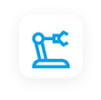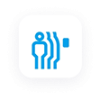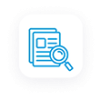With the advancement of better hardware components and robust sensor technologies, robots have proliferated across lengths and breadths of industrial applications in multiple domains. Today, the new average global robot density in the manufacturing industry is 126 robots per 10,000 employees, while the agricultural robot market is projected to reach $11.9 billion by 2026.
Agriculture robots are capable of navigating through different farm layouts and outdoor obstacles like swamps, logs, pits, and uneven terrains. A robust navigation system is a fundamental requirement for these robots to operate in a complex outdoor environment and make accurate topological assessments. The obstacle detection system in robots relies on LiDAR sensors for remote sensing, allowing them to map the surrounding environment independently without relying on GPS. LiDAR sensors enable robots to operate autonomously by facilitating object identification, perception, and collision avoidance.
How Hokuyo URM 2D Lidar Sensor Transforms Agriculture
Hokuyo’s outdoor-rated URM-40LC-EWT 2D LiDAR sensor offers high-level accuracy and scanning speeds for agriculture robot navigation systems. This LiDAR sensor ensures that agriculture robots get precise information in real-time to perform complex tasks such as environmental monitoring, weeding, soil analysis, or even precision agriculture in a reliable manner.
With a 40m range, these sensors can be deployed to perform localization and navigation tasks in the most challenging outdoor environments. The URM-series LiDAR sensors also offer the required temperature resistance for outdoor applications and work effectively between a -10°C to +50°C temperature range. With the IP67 protection and multi-echo integration, these sensors help carry out object detection and environmental mapping in all weather farm conditions.
Some of the key features of the sensor include:
- The hybrid LiDAR sensor has two modes: data output and area configuration mode.
- It is equipped with a 100BASE-TX auto-negotiation ethernet interface for fast communication, while measurement data can be obtained in a 270° field of view.
- The normal mode sensor speed is 25ms with a 0.25° resolution, while the high-resolution mode offers a 50ms scanning speed in 0.125° resolution.
- Due to the weight (450g) and dimensions (L80mm × W80mm × H95mm), these sensors are incredibly portable and easy to integrate with any design.
Overall, URM series sensors improve robot perception and prepare them to operate autonomously. Following are some of the tasks robots can carry out in a farm environment with these 2D LiDAR sensors.
Precision Agriculture
Precision agriculture refers to the methods where farmers procure the highest yields while expelling minimal resources through automated means. For example, farmers can conduct precise soil analysis by integrating an electrochemical sensor into a robot with a LiDAR-based navigation system. This capability allows farmers to determine the precise crops needed for optimum health and productivity.
Mapping and Surveying
2D LiDAR enables simultaneous localization and mapping (SLAM) capabilities which helps them get acquainted with unknown environments. Growers can use robots with SLAM capabilities to map and project current and future changes in precipitation, temperature, crop output, etc. They can carry out surveys to determine crop health, irrigation requirements, environmental impact, and future requirements for better yields.
Automated Weeding
Autonomous weeding robots rely on camera vision and sensors to navigate the farm and identify flora dissimilar to the selected cultivation. A LiDAR sensor can help these robots navigate efficiently across the farm field for weed removal inside and outside the lane of crops. After identifying weeds, these robots can remove them by laser, mechanical force, or spraying a precise amount of herbicide.
Cattle Herding
Cattle herding is a lesser-known application of autonomous farm robots. Robots can lead cattle to green pastures or away from potential dangers after collecting data from the farm environment. With the required integrations, robots can also monitor cattle’s health through temperature measurement and gait analysis.
Optimize your Agriculture Robot Designs with the URM Series
Agricultural robots can increase yields in a sustainable way, reduce environmental footprint, and lower costs. However, these capabilities are only achievable with the right sensor technology.
At Hokuyo, we design and develop high-quality sensor solutions for various autonomous mobile robot applications (AMRs). Our URM-series LiDAR sensors can provide superior navigation and obstacle detection for robots designed to be used in an agricultural setting.
Check out the specifications of our URM-series 2D LiDAR sensor or contact us to find the best-fit sensor products for your agricultural robot.

 Factory Automation
Factory Automation Logistics Automation
Logistics Automation Process Automation
Process Automation Crane Collision Avoidance
Crane Collision Avoidance LiDAR/Obstacle Detection
LiDAR/Obstacle Detection Safety Laser Scanners
Safety Laser Scanners Optical Data Transmission
Optical Data Transmission Hot Metal Detectors
Hot Metal Detectors Laser Distance Sensor
Laser Distance Sensor Blog
Blog Whitepapers
Whitepapers Case Studies
Case Studies Infographics
Infographics